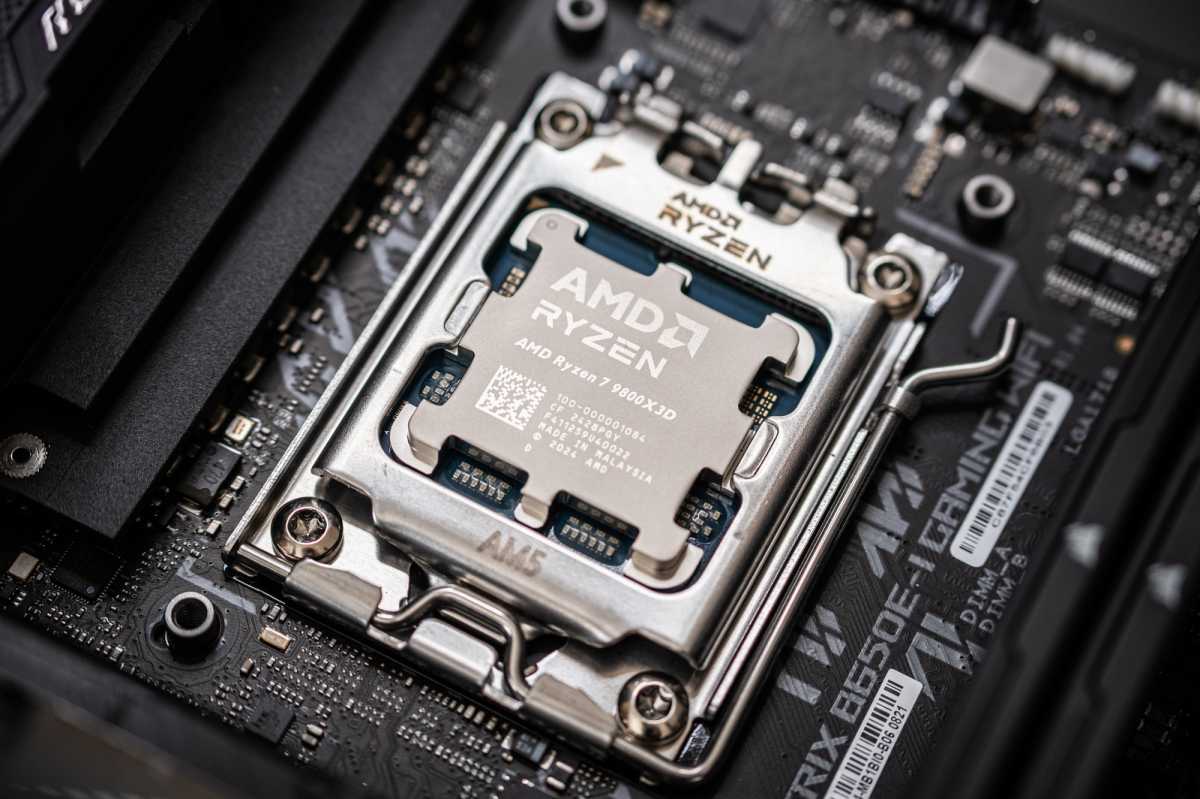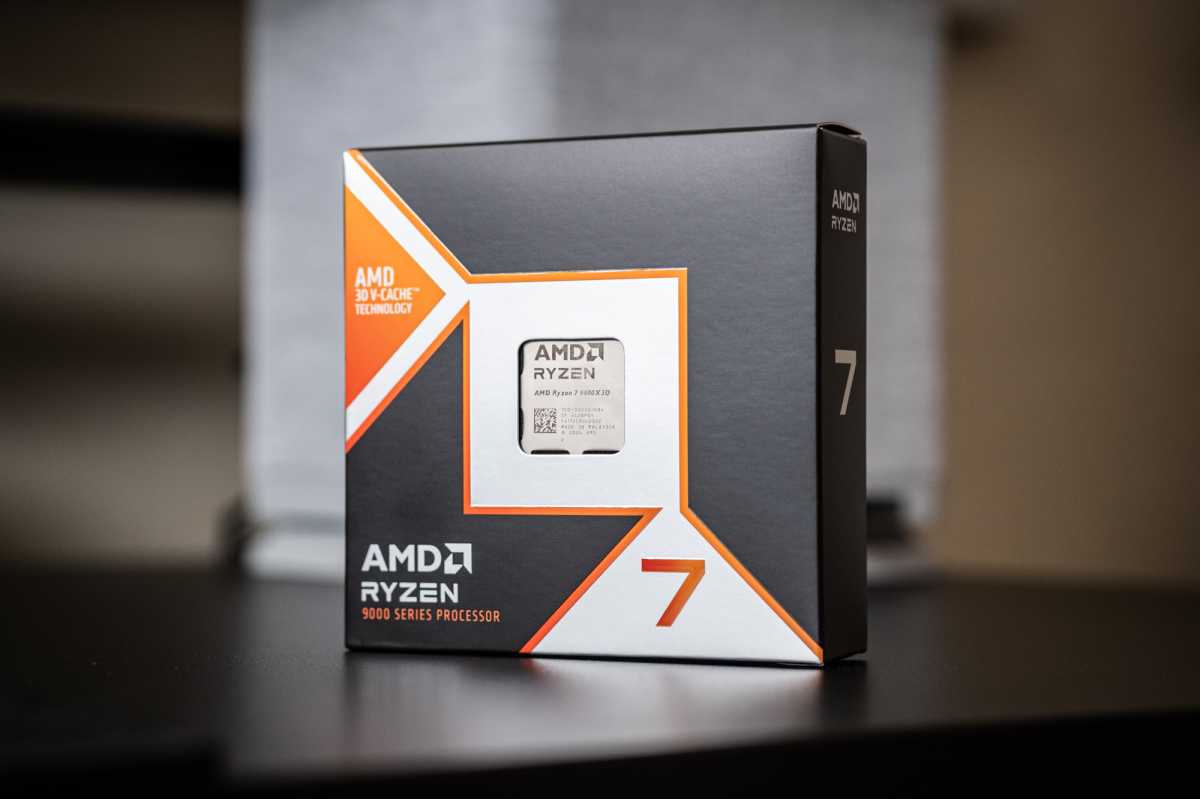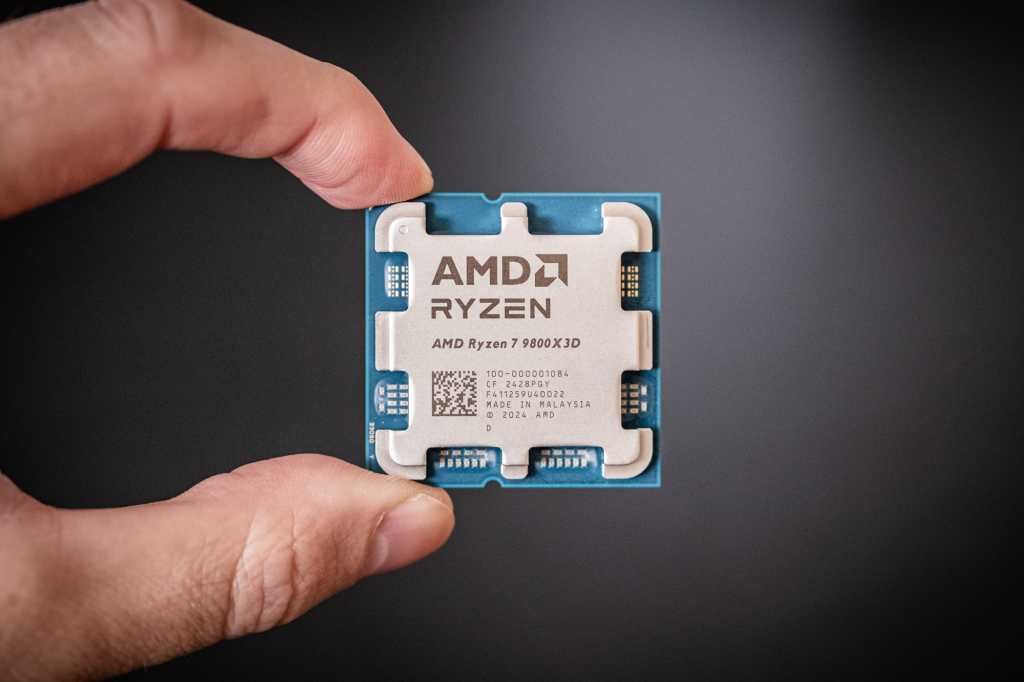AMD’s vaunted “X3D” V-Cache technology vaulted Ryzen processors to the pinnacle of gaming supremacy when it debuted in the legendary Ryzen 7 5800X3D. Now, it arrives with extra pressure on its proverbial shoulders: Can that X3D magic help resuscitate a Ryzen 9000 lineup that’s struggled with ho-hum reviews out of the gate and dramatic performance-altering Windows updates?
Spoiler alert: Absolutely. The Ryzen 7 9800X3D rocks, obliterating Intel’s new Core Ultra 9 285K in games – but that’s not all.
Previous X3D generations always popped in games, but proved lackluster against its non-X3D siblings in creation workloads. Thanks to some smart tweaks to the second-gen V-Cache design, the $479, 8-core Ryzen 7 9800X3D actually gets an even bigger bump in select creator workloads than gaming, compared to its predecessor, and now sits comfortably above the 8-core 9700X for work and play. It’s a monumental moment for AMD – and a monumental beat down for Intel’s gaming ambitions.
Our review of the initial Ryzen 9000 CPUs can get you caught up on crucial platform details about this generation of AMD processors. We’ve already dug into the Ryzen 7 9800X3D’s speeds and feeds, while the video embedded above dives deep into our full testing results for the chip (though you can swipe through all our benchmark graphs below). Here, we’ll explain the five key things you need to know before buying the Ryzen 7 9800X3D… which we absolutely recommend if you’re a gamer.
1. Second-gen V-Cache makes vital improvements
Before we get into the benchmarks, we need to quickly talk about how AMD achieved such sterling results.
The Ryzen 7 9800X3D introduces the second generation of AMD’s V-Cache technology, and it’s a winner. In previous X3D generations, the slabs of cache sat on top of the Ryzen CPU dies, which resulted in them not being able to clock as high as their non-X3D siblings due to heat concerns – and you couldn’t overclock them at all. So the Ryzen 7 5800X3D and 7800X3D were slower than their non-X3D counterparts in many non-gaming workloads.
Adam Patrick Murray / Foundry
Say goodbye to those limitations with the 9800X3D and its new-style V-Cache. Here’s AMD describing the tweaks:
“AMD has re-engineered its cutting-edge on-chip memory solution with 2nd Gen AMD 3D V-Cache technology. The 64MB cache memory has been relocated below the processor, which puts the core complex die (CCD) closer to the cooling solution to help keep the “Zen 5” cores cooler, delivering high clock rates and providing up to an average 8% gaming performance improvement compared to our last-gen generation and up to an average 20% faster than the competition. This revolutionary change in placement allows for extreme overclocking of the processor.”
End result? The Ryzen 7 9800X3D has a much higher, 4.7GHz base clock speed than both the Ryzen 7 9700X and the older Ryzen 7 7800X3D, while also bumping up maximum clock speeds to 5.2GHz and also allowing you to (finally) overclock the processor.
2. A gaming legend indeed
With those changes in tow, the Ryzen 7 9800X3D absolutely slaps in games – and slaps Intel’s flagship Core Ultra 9 285K around in the process.
In the four games we tested, the Ryzen 7 9800X3D runs an average of 25 percent faster than the 285K at 1080p resolution. That’s a massive unheard-of gulf, and it’s actually being dragged down by the results in Total War Warhammer 3, which runs similarly on every processor we tested. If you take that out, the 9800X3D runs a whopping 30 percent faster than Intel’s biggest dog. It’s 45 percent faster than the 285K in Cyberpunk 2077 with ray tracing off.
Madness! I can’t remember the last time I witnessed a hardware beat down this relentlessly violent. If you want the single best gaming chip you can buy, the Ryzen 9 9800X3D is it.

Adam Patrick Murray / Foundry
AMD’s newcomer also bests the company’s productivity flagship, the Ryzen 9 9950X, in gaming – no surprise there given the Ryzen 9’s dual-CCD design, which can impact gaming frame rates.
Interestingly, the 9800X3D isn’t all that much faster in our tested games than its predecessor, the 7800X3D. But that’s not the case when it comes to, well, everything but gaming.
3. Shockingly good creation chops
Eight-core CPUs are the sweet spot for most folks who game and dabble in tasks like streaming and basic video editing, and the second-gen V-Cache in the 9800X3D makes it a much more compelling option for work than its predecessors.
Unlike prior X3D chips, the 9800X3D is demonstrably faster than the vanilla 8-core chip in AMD’s Ryzen lineup – the 9700X, here. We tested the 9700X in both its stock 65-watt configuration, as well as with the 105W option unlocked via a BIOS update. The 9800X3D soundly trounces the 9700X’s default performance, and manages to keep its lead even when you juice the vanilla chip with abundant extra power. We haven’t seen this before, and it’s a huge feather in the 9800X3D’s cap.
That’s notable. But what really drives home the point is the difference between the 9800X3D and the 7800X3D in creative workloads, especially given their neck-and-neck performance in gaming.

Adam Patrick Murray / Foundry
The 9800X3D is 24 percent faster than the 7800X3D in Cinebench’s multi-thread test, despite both being 8-core chips with connected V-Cache. It’s roughly 25 percent faster in Blender workloads. That leaps up to a whopping 35 percent faster during Handbrake video encodes. The torrid pace slows in Premiere Pro and Photoshop, to a still-valiant 13 and 18 percent respectively, while Davinci Resolve is the least impressive result, with the 9800X3D landing about 7.5 percent faster than the 7800X3D.
These are phenomenal results, full stop, and ones that eradicate the previous caveats associated with Ryzen X3D chips. Choosing the Ryzen 7 5800X3D or 7800X3D meant you got top-tier gaming performance, but non-gaming tasks suffered compared to their vanilla siblings. That’s not the case anymore. The Ryzen 7 9800X3D outshines the 9700X in every way – and it’s often not close, especially if you’re using the 9700X’s default 65W configuration.
Don’t hear what I’m not saying: If you’re a person who does heavy, crunchy creation tasks, you’re generally going to be better off going for the Ryzen 9 9950X or Core Ultra 9 285K, both of which come loaded with way more CPU cores than AMD’s new X3D vanguard and offer correspondingly higher performance (at, yes, higher prices). But the 9800X3D can easily handle what the vast majority of folks will throw at it.
4. It’s more expensive
So the Ryzen 7 9800X3D is the single best gaming chip you can buy, and it’s now a very solid chip for non-gaming tasks too. Excellent! But you don’t get those benefits for free.
At $479, the Ryzen 7 9800X3D costs $30 more than its predecessor, and a whopping $130 more than the 9700X – an interesting price since the 9800X3D chip was only about 14 percent faster than the 9700X in our gaming tests. If you want the very best gaming performance, though, you have to pay for it. It’s also worth pointing out that the 9800X3D is $110 cheaper than Intel’s Core Ultra 9 285K. AMD’s chip whups on Intel’s in games, while Intel’s shoves AMD’s chip around in multi-core workloads.
5. Should you upgrade your 5800X3D?

Adam Patrick Murray / Foundry
Finally, the big question: What should you do if you already own a Ryzen 7 5800X3D system? Lots of enthusiasts snatched up the legendary chip during fire sales in recent years, and were waiting to see how the Ryzen 9800X3D performed after skipping the 7800X3D.
Going off the numbers alone, the 9800X3D is 25 percent faster than the 5700X3D (which is clocked 400MHz lower than the 5800X3D) in our gaming tests, and a whole lot faster than that in content creation tasks. The 5800X3D should be about 7 percent faster than the 5700X3D. On the surface, that makes the 9800X3D seem like a very fine upgrade indeed. But should you bite the bullet?
For people who demand the newest technologies and the bleeding edge of gaming speed, it makes sense. If you take a step back, however, the beloved 5800X3D – which came out years ago – is just as fast if not faster than Intel’s 285K flagship. So it remains a very potent gaming chip, and the 9800X3D’s gaming uplift won’t be as pronounced at 1440p or 4K resolution, where gaming bottlenecks tend to get shifted more towards GPUs.
Upgrading from the 5800X3D to the 9800X3D doesn’t just mean spending $479 on the chip, either – you’ll also need to upgrade to a new AM5 motherboard, and snag some newfangled DDR5 memory to go with it. All-in, you’re looking at a total platform upgrade cost pushing nearly $800 or more, even if you keep your existing graphics card, case, power supply, and so on.
Again, if you seek the very best gaming firepower, it could make sense, and doubly so if you stream or use your PC for other demanding workloads – the 9800X3D’s content creation leap is breathtaking, and the AM5 platform supports newer technologies like PCIe 5, DDR5, and USB 4. But if you’re mostly a gamer, and the 5800X3D is still spitting out ferocious frame rates in your games of choice, saving your cash for a baller new graphics card is probably a better bang for your buck despite how fantastic the 9800X3D is.

